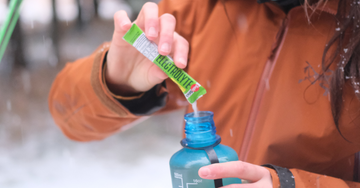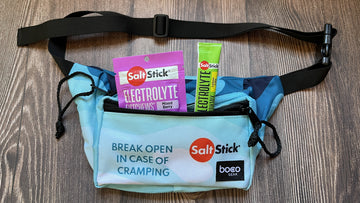
 Now that the holidays are over, most endurance athletes will begin base training for the summer. Enter, popular new year's resolutions and exit, cakes and pies, replaced with indoor trainers and dumbell sets. With cold temperatures and icy roads the norm for many athletes, and the earliest of races still months away, winter is the best and most popular time to build an endurance base.
Still, all the indoor training can sometimes be demotivating. (After all, while six-hour workouts on an indoor bike can be done, they are nowhere near as enjoyable.) Luckily, snow usually accompanies the colder temperatures, which provides the opportunity to get a fantastic cross-training workout. Plus, given that playing in the snow is just good fun, it can do wonders for providing that extra boost of motivation to stay active.
Before attempting any of these activities, be sure to fuel properly!
While you may not notice it as much, you still sweat in the cold, and you will need to replace lost calories, water and electrolytes to ensure you stay hydrated and fueled all day.
How SaltStick can help: As any endurance athlete knows, significant dehydration is the enemy of performance. Thirst is a good indicator for low fluid levels in warm temperatures, but you cannot rely on thirst alone when it is cold outside. You still need to drink water and replenish electrolytes -- even if you don’t feel thirsty -- and the suggested intake of 1-2 SaltStick Caps per hour remains appropriate, though as always, usage depends on your unique physiology, training, and conditions.
Also, ski trips tend to include a lot of caffeine and alcohol consumption, which can contribute to dehydration as well. (On a side note, if you find you have overdone it on the Après ski festivities, SaltStick can also help with hangovers.)
After you have made a plan to stay hydrated and fueled, you can freely enjoy the calorie-burning, fitness-improving, strength-increasing benefits of the following winter activities:
Now that the holidays are over, most endurance athletes will begin base training for the summer. Enter, popular new year's resolutions and exit, cakes and pies, replaced with indoor trainers and dumbell sets. With cold temperatures and icy roads the norm for many athletes, and the earliest of races still months away, winter is the best and most popular time to build an endurance base.
Still, all the indoor training can sometimes be demotivating. (After all, while six-hour workouts on an indoor bike can be done, they are nowhere near as enjoyable.) Luckily, snow usually accompanies the colder temperatures, which provides the opportunity to get a fantastic cross-training workout. Plus, given that playing in the snow is just good fun, it can do wonders for providing that extra boost of motivation to stay active.
Before attempting any of these activities, be sure to fuel properly!
While you may not notice it as much, you still sweat in the cold, and you will need to replace lost calories, water and electrolytes to ensure you stay hydrated and fueled all day.
How SaltStick can help: As any endurance athlete knows, significant dehydration is the enemy of performance. Thirst is a good indicator for low fluid levels in warm temperatures, but you cannot rely on thirst alone when it is cold outside. You still need to drink water and replenish electrolytes -- even if you don’t feel thirsty -- and the suggested intake of 1-2 SaltStick Caps per hour remains appropriate, though as always, usage depends on your unique physiology, training, and conditions.
Also, ski trips tend to include a lot of caffeine and alcohol consumption, which can contribute to dehydration as well. (On a side note, if you find you have overdone it on the Après ski festivities, SaltStick can also help with hangovers.)
After you have made a plan to stay hydrated and fueled, you can freely enjoy the calorie-burning, fitness-improving, strength-increasing benefits of the following winter activities:
1. Skiing or Snowboarding
Perhaps two of the best winter cross-training activities around, skiing and snowboarding each comprise full-body workouts as well as a massive dose of cardiovascular work. Proper form dictates that your legs and core are near-constantly engaged as you descend, and the continual changes in direction will force you to use your lateral (sideways-moving) muscles a lot more than running and biking, making you a more balanced athlete overall. Energy Burned (Note: All calorie counts are based on moderate exertion by a 150-pound adult.): 400 calories per hour Endurance Benefits: Strengthens ankles, improves balance, improves cardiovascular performance2. Cross-Country Skiing
Very similar to skiing downhill, cross-country skiing can also have direct benefits to endurance athletes through its full-body nature. This winter activity “uses just about every muscle in your body,” Gale Bernhardt, an Olympic cycling and triathlon coach, told Competitor magazine. This translates into improved balance, leg strength, core strength, and -- especially important for those athletes looking to build an endurance base this winter -- cardiovascular performance. Of the top-ten VO2 max numbers (which measures the maximum capacity to transport and use oxygen) ever recorded, five are from cross-country skiers. Energy Burned: 540 calories per hour Endurance Benefits: Improves cardiovascular performance, strengthens legs and core, increases balance3. Sledding
While you don’t see sledding listed as an Olympic sport, it is nonetheless a great cross-training workout for endurance athletes. Unlike skiing and snowboarding, you have to manually drag your equipment uphill: Do that 100 times and you will get a great leg workout! Plus, it’s just so much easier to stay motivated (who really thinks about exercise while they are sledding with friends and family?) when you’re having a good time and some warm hot cocoa is waiting for you back home. Energy Burned: 480 calories per hour Endurance Benefits: Strengthens legs, maintains cardiovascular fitness, provides a “mental break” from winter training
4. Snowball Fighting/Playing
There is no need for a formal workout structure to achieve fitness benefits, especially when you have something as fun as playing in the snow! In fact, with all the rolling, scooping, throwing and running involved in a snowball fight, you can burn upwards of 500 calories an hour. It is little wonder you feel so exhausted when you are done. Energy Burned: 520 calories per hour Endurance Benefits: Maintain cardiovascular fitness, improves overall conditioning by using non-running/biking muscles, provides a “mental break” from winter training5. Shoveling Snow
Unless you are one of the lucky few who live in an apartment or complex that takes care of the sidewalks and driveways for you, one of the less-enjoyable tasks you will be faced with this winter is shoveling snow. But there is no reason to hate it, especially when you realize you can treat it as a workout. As long as you use proper form (BEND those knees!), all the scooping, digging, pushing, pulling and bending will contribute to a great strength and conditioning workout. To really up the intensity, turn the job into an interval workout: sets of 10 minutes of running separated by five minutes of shoveling snow. The faster you shovel, the less time you have to spend outside! (Mastered the interval workout? The Huffington Post has its own list of “snow-shoveling workouts” that you can try.) Energy Burned (Without the running intervals): 420 calories per hour Endurance Benefits: Improves total body strength, maintains cardiovascular fitness6. Ice Skating:
Outdoor ice skating is not available to everyone, but most endurance athletes should have access to an indoor ice skating rink year-round. Regardless of when you go, know that you are getting an excellent cross-training workout. In fact, many speed skaters use cycling as a way to cross-train in the summer months, and the reverse works just as well. When Apolo Ohno competed in the Ironman World Championships, he attributed much of his cycling strength to his background as a speed-skater. Note: If you don’t know how to ice skate, you may not get as many of the cross-training benefits. Still, any time on your feet almost always better spent than sitting in a chair waiting for the weather to warm up! Energy Burned: 480 calories per hour Endurance Benefits: Improves cardiovascular fitness, increases leg strength
7. Snowshoeing
As Runner’s World points out, snowshoeing is a great way to maintain or even improve your aerobic engine. “Just like hill running can build aerobic strength, the energy cost of snowshoeing is like hill running super-sized,” the magazine writes. Plus, “if you can walk or run, you can snowshoe,” making it an easy and cost-effective method to maintain your fitness during the winter. Energy Burned: 540 calories per hour Endurance Benefits: Increases leg and core strength, improves cardiovascular fitnessWhat is your favorite way to workout in the snow? Leave your thoughts in a comment!
Important Note: The above should not be construed as medical advice. Contact your physician before starting any exercise program or if you are taking any medication. Individuals with high blood pressure should also consult their physician prior to taking an electrolyte supplement. Overdose of electrolytes is possible, with symptoms such as vomiting and feeling ill, and care should be taken not to overdose on any electrolyte supplement.
Tags:








